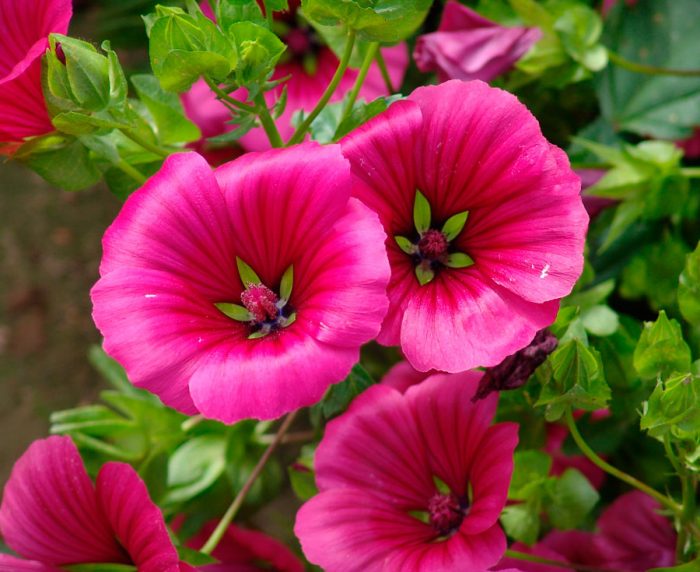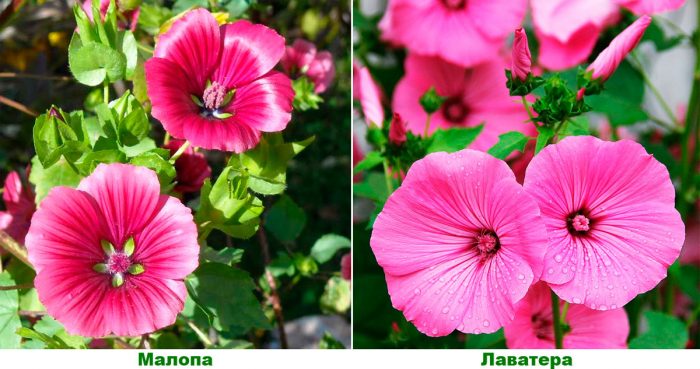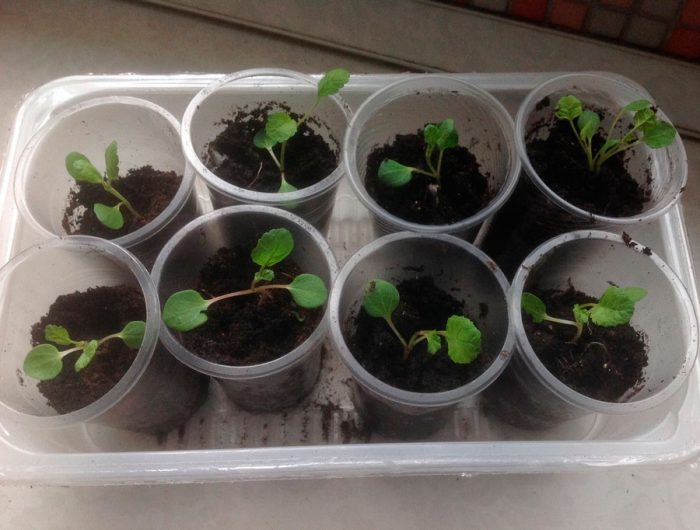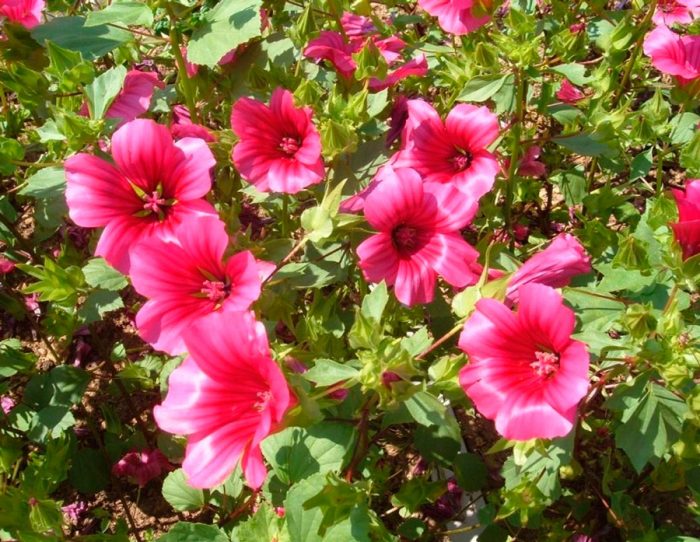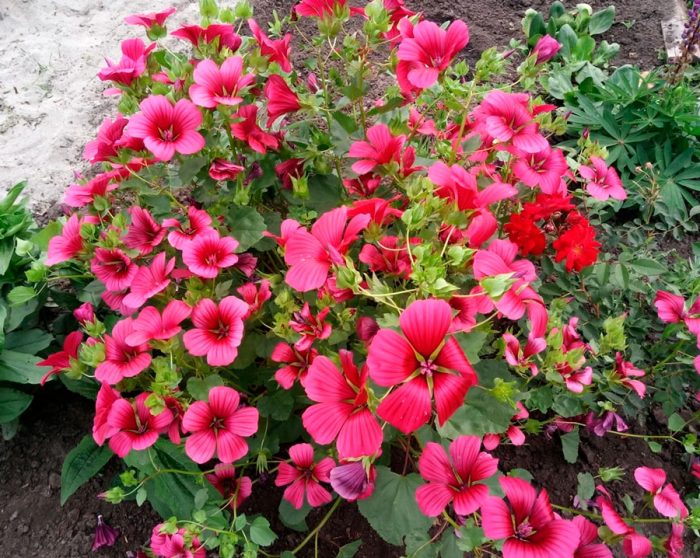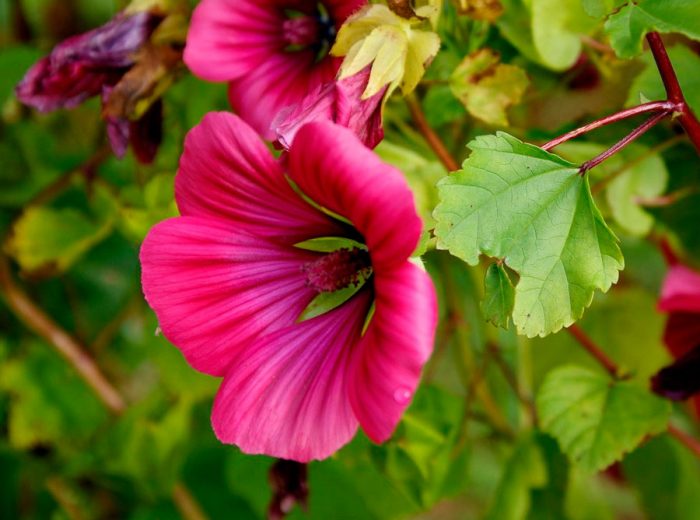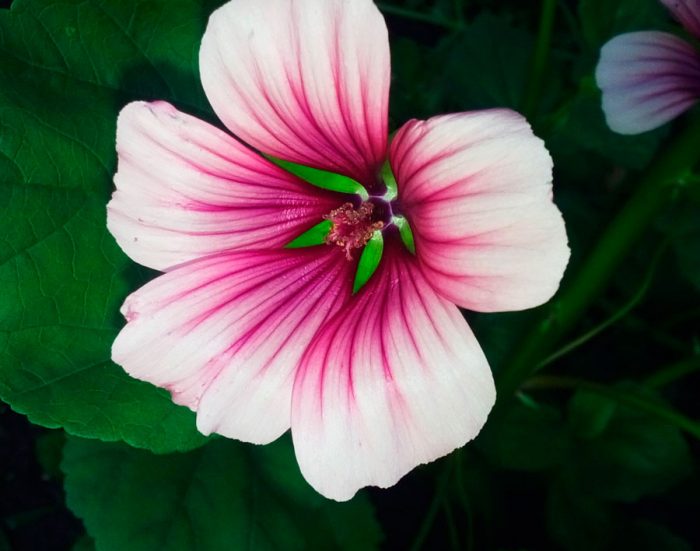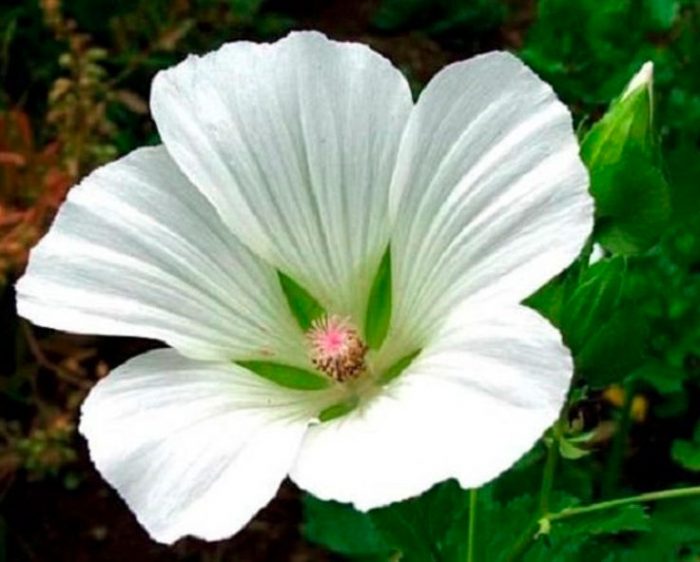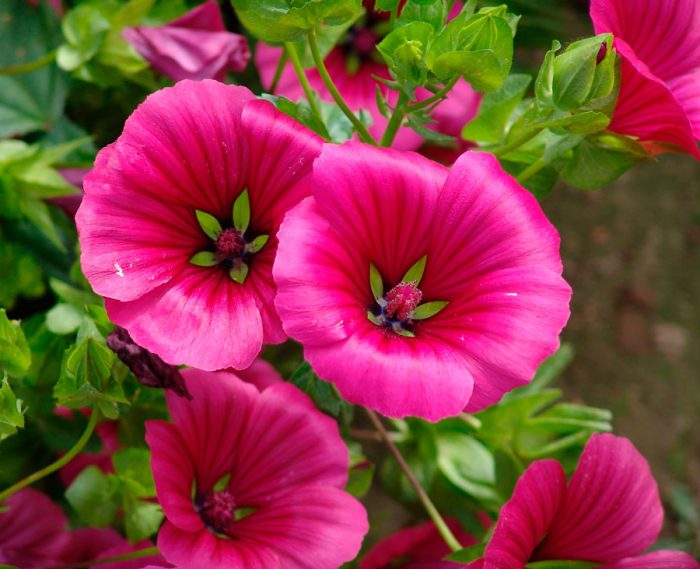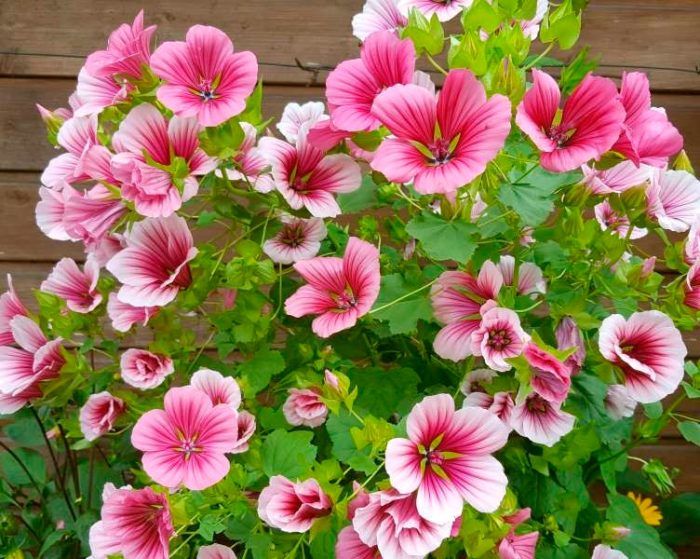If you want to decorate your garden or house with some unusual and very spectacular flower, then Malopa is perfect for you. This flower is currently very poorly distributed in mid-latitudes, so it will certainly become the main decoration of your site.
Content
Features of malopa
The herb malopa in nature can be found in the Mediterranean. The people often call it a hole. It is part of the Malvaceae family. Such a plant today can be found not only in nature, it is also cultivated in the open ground and in indoor conditions.
During flowering, Malopa bushes look the most decorative. During this period, large funnel-shaped flowers are revealed on them, which are highly decorative. The flowers of mallow and malopa have a lot of similarities, but there are differences between them. At the hole, the flowers are more graceful and have a more intense color.
Both in nature and in the garden - this plant is an annual. Depending on the variety, the bushes can be either medium-sized or relatively high: from 40 to 100 centimeters. The stem at the hole is strongly branched. The foliage has a spectacular heart-shaped shape with jagged edges at the edge. During flowering, the bush is decorated with single flowers. Their corolla consists of five bright petals. If pollination occurs, then about fifty small seeds will form in place of each flower.
Most often, such a flower is cultivated in the open field, decorating a garden plot with it. In mid-latitudes, it grows and develops quite well, and blooms effectively. However, it can also be found in indoor conditions, where it also feels great when certain conditions for growth are created.
What is the difference between malopa and lavatera
Inexperienced gardeners often confuse some varieties of malopa with another horticultural crop - lavatera. But these are completely different plants that differ significantly from each other.
Most often, these cultures are distinguished among themselves in size. Lavater has smaller flowers than Malopa. And also her bushes are smaller due to shorter shoots. These differences are usually enough to determine which flower is in front of you: a hole or a lavater.
Planting malopa in open ground
Growing from seed to seedlings
It was already mentioned above that the malopa grown in the garden is an annual. That is why it has to be grown from seed every year.
This crop is grown through seedlings, while the sowing time of seeds depends entirely on the climatic conditions of your region. You can sow seeds of malopa throughout the spring, the main thing should be taken into account that when the time comes for transplanting seedlings into open ground, the air outside should already be well warmed up. And you should also take into account that even a slight frost can harm flowers. Therefore, it is so important that return spring frosts are left behind.
Before proceeding with the direct sowing of seeds, you need to prepare special seedling boxes. They are filled with loose peat soil. Malopa seeds are small and can break easily if you press hard on them. Therefore, after they are evenly distributed over the surface of the substrate, they only need to be pressed a little into the soil. Sprinkle them on top with neither substrate nor sand.
After the seeds are sown, you need to moisten the crops. It is recommended to water them with a sprayer. This will protect the seeds from washing out, and you can also avoid stagnation of moisture in the soil mixture, which can negatively affect young, immature seedlings. Next, it is very important to cover the top of the box with transparent glass or film. This will help prevent the surface of the substrate from drying out and maintain the required moisture level.
Do not forget to systematically ventilate and moisten the crops, and immediately after the first shoots appear, be sure to remove the shelter. Young seedlings are rearranged in a well-lit place, protected from direct sunlight. They are also provided with regular, moderate watering. It is recommended to transplant the seedlings into separate cups after the first true leaf plates appear.
Landing in the garden
When planting grown seedlings of holes in open ground, you need to be extremely careful not to injure both the stems and the root system of the plant.
The first step is to prepare the site for planting. The soil is dug in advance, while a little organic matter is introduced into it. Prepare the planting holes just before planting the plants. Their depth can vary from 50 to 100 mm. The row spacing, as well as the distance between the bushes, should be at least 30–35 centimeters. Plant malopa in prepared holes and water well.


Watch this video on YouTube
Caring for a little boy
It is very easy to take care of a duck growing in open ground, so even a novice gardener can cope with this task. Such a culture is distinguished by its unpretentiousness and undemanding care. But if you want the bushes to grow strong and tall, and during flowering they are decorated with many flowers, then the hole should be provided with good regular maintenance.
Watering
While the bushes are young, they must be watered systematically and abundantly. Thanks to timely and sufficient watering, the plant adapts much faster and easier to new growing conditions. And the correct hydration of the bushes has a positive effect on their growth.
After the bushes, planted in open ground, grow up and get stronger, they are watered only as needed. In a rainy summer, they can do without watering at all. However, during a long hot and dry period, do not forget to systematically water the malopa, otherwise it may lose its decorative effect.
Top dressing
Also, when growing a hole in your garden, it is important to pay sufficient attention to its feeding. The first step in choosing a site for planting is to pay attention to the fact that the soil must be nutritious.If initially the land is poor or depleted, then the bush will not be able to grow and develop within normal limits.
But despite the fact that the malopa will be planted in fertile soil, it will still need timely feeding throughout the growing season. It is recommended to feed such a plant with special complex mineral fertilizers intended for flowering crops. These can be purchased from a specialist store. Please note that it is possible to introduce organic matter into the soil only during the preparation of the site for planting. In the future, in no case can it be used to feed the hole.
Pruning
Malopa, growing in the open field, tolerates pruning very easily, and she just needs it to maintain the health and neat appearance of the bush. If the inflorescences that have begun to fade, as well as other parts of the bush that are damaged or affected by the disease, are promptly cut off, then the growth and development of new shoots will accelerate due to this. In addition, timely pruning will preserve the high decorative effect of the bush for a long time.
Reproduction methods
It has already been said above that the annual malopa plant can be propagated only by the generative (seed) method. If such a beautiful plant is already growing in your garden, then you can collect the seed material yourself. When the seeds are fully formed and ripe, they can be collected, dried, and folded into paper bags for storage. But be very careful, because fragile seeds are easily injured.
You can also grow a hole from seed purchased from a specialized store. Moreover, most gardeners prefer to use store seeds for sowing, since they have a higher percentage of germination.
In middle latitudes, sowing seeds of malopa directly into open soil is not carried out. This plant is only grown through seedlings. Home-grown seedlings can easily tolerate planting in open ground.
When choosing a site for growing a hole in the garden, you need to pay special attention to several factors:
- it must be sunny;
- the soil must be saturated with nutrients, as well as minerals;
- groundwater must lie quite deep, otherwise the flower may die.
Diseases and pests
Malopa has a fairly high resistance to both diseases and pests. But sometimes, nevertheless, gardeners may have problems with this culture, especially if an unsuitable site was chosen for planting it or if the bushes were not provided with good enough care.
Pests
Various pests can settle on Malopi bushes, while the most frequent "uninvited guests" are the following:
- Spider mite... It feeds on plant sap, which it sucks out by making small holes in foliage and in young shoots. Because of this, the foliage begins to actively turn yellow and deform. To protect the plant from the possible negative consequences of the activity of spider mites, experts advise, as soon as possible, to start treating the bush with special pesticides. Most often, Actellik solution or Fitoverm is used for this.
- Aphid... Aphids are also a sucking insect that feeds on plant sap. In the affected bush, weakening of leaves and shoots is observed. You can get rid of such a harmful insect by the same means that are used in the fight against spider mites.
- Nematodes... Such small pests affect the underground part of the plant, or rather, its roots. You can get rid of them only with the help of powerful toxic chemicals, for example: Karbofos, Nemagon or Zoolek Capisol.
Diseases
The hole is also susceptible to some diseases, for example:
- Powdery mildew... Such a disease develops if moisture stagnation is observed in the soil.To cure a sick plant, you can use folk remedies, for example, an infusion or decoction of onion husks. However, in advanced cases, it is better to immediately use a fungicide solution, for example, Topaz or Fundazol.
- Rust... In a diseased plant, specks form on the surface of the foliage. To cure it, repeated treatment with a solution of copper oxychloride, Bordeaux mixture or Oxychoma is required. Do not forget to cut off all diseased parts of the bush before spraying.
Types and varieties of malopa with photos
At the moment, experts have found and described 3 species of malopa that are found in natural conditions, namely: Malope anatolica, Malope trifida and Malope malacoides. As a result of the work of breeders, a large number of varieties have appeared for each of these three species.
The best varieties:
Diamond rose
A vigorous bush can be about 90 centimeters high. The large flowers of such a plant are very spectacular, they have a burgundy or white color.
Purpurea
This variety stands out among the rest with an unusual color of flowers - bluish-red.
Belyana
This variety was named so because its flowers are snow-white. The long stems can reach a height of about 100 cm.
Glaser
This hybrid plant also stands out from the rest of the varieties with its unusual corolla coloration. She can combine several shades at once: pink, white, burgundy, black, etc.
Beautiful girl
Among other varieties, such a plant stands out favorably for its very large flowers, which can reach up to 100 millimeters in diameter.
Purple
This variety has the longest stems. The bush is often about 120 centimeters high.
Malopa in landscape design
Malopa has found quite wide application in landscape design. Depending on the variety, such a flower is used to create flower beds, rock gardens, mixborders, slides, etc.
In addition, the flower is cultivated at home, and it is also suitable for decorating loggias and balconies. In this case, the bushes are planted in special flowerpots, containers or pots.
The hole goes well with the following garden flowers: marigolds, dahlias, zinnias, chamomile, etc. In this case, you need to pay special attention to the choice of colors, as well as the size of the bushes.
Often the hole is used when decorating a plot in a "rustic" style. It looks harmoniously against the background of a picket fence, a wicker fence, and also near the gazebo and along the paths.


Watch this video on YouTube

